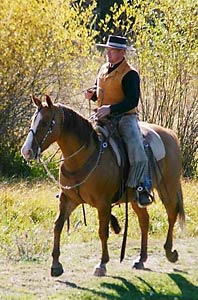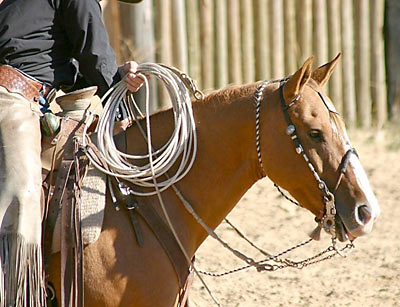|
Addressing Your Horse Bit Problems
By Christopher J. Bohenek, Clinician & Trainer
If there is one issue that comes up time and again with most of my clients, it is the subject of bits.
For many of my clients, bit issues are the most frequently mentioned problem. Does it sound familiar? When asked about the issue,
clients will often give the same response on bits - the most common one being that they've tried a variety of bits --- rubber snaffles,
twisted wire snaffles, tom thumbs, curb bits, grazers and of course mechanical hackamores (which should not be confused with the
traditional rawhide hackamore of the Vaquero heritage) This often brings along the same response from their horse, sadly, not the one they were seeking.
 Usually, there is the same misunderstanding that if one bit does not work, another one certainly
must be the answer. The thinking often is, and quite mistakenly, to keep on increasing the severity
of the bit applying more and more pressure and fear to get the horse to do what they want or get away from the bit altogether as in the mechanical hackamore. There is the unique situation when a
horse has been treated harshly with the bit, let's say the snaffle, where they might be very bothered and preoccupied with the bit in their mouth, keep in mind the way a horse might be reacting to the
bit in a situation like this, ends up being 90% mental. A horse if they have been handled incorrectly with the bit will start to have anxiety and fear over what happens when the bit is placed in their
mouth, they will associate the bit with whatever happened to them the last time the bit was in their mouth ("horses remember what happened, before what happened, happened".) This is very
common of horses that have not been a given a release quickly when they have gotten soft, or one that has been abused by severe pulling on the bit or has had their head tied to the saddle left, right
or vertical. This type of horse will mentally "lock up" and seem to block out what it is you are trying
to teach them, simply because of the issue they are having with the bit. This situation, is the one time that I would try to help the horse by getting away from the bit for a while and riding them in a
traditional rawhide hackamore, by doing so I can eliminate the mental problem the horse might be
having with the bit. This will allow me to get to the horses feet and help them understand how to position them selves properly, freeing
up their mind. As the horse progresses and gets comfortable with me guiding him I would then go back and "reintroduce" the snaffle
to the horse, with the hopes that by getting the feet "unstuck" the mental end of things with the bit will slowly come to pass. Usually, there is the same misunderstanding that if one bit does not work, another one certainly
must be the answer. The thinking often is, and quite mistakenly, to keep on increasing the severity
of the bit applying more and more pressure and fear to get the horse to do what they want or get away from the bit altogether as in the mechanical hackamore. There is the unique situation when a
horse has been treated harshly with the bit, let's say the snaffle, where they might be very bothered and preoccupied with the bit in their mouth, keep in mind the way a horse might be reacting to the
bit in a situation like this, ends up being 90% mental. A horse if they have been handled incorrectly with the bit will start to have anxiety and fear over what happens when the bit is placed in their
mouth, they will associate the bit with whatever happened to them the last time the bit was in their mouth ("horses remember what happened, before what happened, happened".) This is very
common of horses that have not been a given a release quickly when they have gotten soft, or one that has been abused by severe pulling on the bit or has had their head tied to the saddle left, right
or vertical. This type of horse will mentally "lock up" and seem to block out what it is you are trying
to teach them, simply because of the issue they are having with the bit. This situation, is the one time that I would try to help the horse by getting away from the bit for a while and riding them in a
traditional rawhide hackamore, by doing so I can eliminate the mental problem the horse might be
having with the bit. This will allow me to get to the horses feet and help them understand how to position them selves properly, freeing
up their mind. As the horse progresses and gets comfortable with me guiding him I would then go back and "reintroduce" the snaffle
to the horse, with the hopes that by getting the feet "unstuck" the mental end of things with the bit will slowly come to pass.
Let's look at this some more. As mentioned above, the problem does not lie with the type of bit but more importantly, the way the
person is using the bit on the horse. Horses need to always have a release whenever anything is asked of them. This is absolutely
crucial to developing a soft, supple horse with a good learning frame of mind, that responds out of a willingness to please, and trusts what you are asking is for their best interest.
 If the rider spends time learning how to be consistent and
proficient in this, getting their feel, timing and balance in tune with the horse and allowing the horse to do something I refer to as
"hunting and gathering," the horse will soon come to understand what is being asked of them. It will then be the horse that will
start "hunting-up" the release and "gathering" the information giving the horse their own reservoir of knowledge to dip into
when it is needed. If the horse learns to brace at liberty or on the halter or in the bridle, it will eventually brace against everything
that is offered to it. This is why correct timing of the release is so important, and gimmicks like tying your horse's head latterly or
vertically to the saddle will only work for so long before the horse eventually "braces" up when life is created. If the rider spends time learning how to be consistent and
proficient in this, getting their feel, timing and balance in tune with the horse and allowing the horse to do something I refer to as
"hunting and gathering," the horse will soon come to understand what is being asked of them. It will then be the horse that will
start "hunting-up" the release and "gathering" the information giving the horse their own reservoir of knowledge to dip into
when it is needed. If the horse learns to brace at liberty or on the halter or in the bridle, it will eventually brace against everything
that is offered to it. This is why correct timing of the release is so important, and gimmicks like tying your horse's head latterly or
vertically to the saddle will only work for so long before the horse eventually "braces" up when life is created.
Therefore, if the horse braces against you, the solution is not to
go to a "correction bit" with more leverage or pressure points, nor is it in most cases, (except in the situation mentioned above),
should the bit be taken away altogether as in the case of a mechanical hackamore, which creates a tremendous amount of pressure on
the nose and works nothing like a traditional rawhide hackamore, this would be like putting a band-aid on a broken arm. If the horse's
teeth have been taken care of and there are no problems present, then the problem lies with the human and their inability to communicate correctly with the horse.
The answer is never to increase the severity of the bit for correction purposes! It is the rider who must always strive to release the
horse, be it with the bit or with the legs. When we talk about release of the horse, this could be anything from a shift in the horse's
weight, to a relaxation of their muscles or just a change in their expression - whatever it is that the rider is asking when the horse makes the slightest try.
With this being done (release), the horse will come to understand that as long as they try; no matter how slight the response there will
always be a release and reward for their effort. So in turn, they'll start "hunting" up the release and "gathering" the information within it.
Therefore (and this cannot be repeated enough), if a horse braces in the snaffle and you move to a new bit or piece of equipment such
as the mechanical hackamore, you might see some difference at how they respond at first, but in a short amount of time, if the rider
continues to go on without any "feel," never giving release and lacking the knowledge to rehabilitate the horse to better horsemanship,
the horse will very quickly learn to brace against that piece of equipment as well.
Ultimately, it all comes back to the human causing the problem, not the horse. Horses are not born with these braces, they are man
-made and we are the only ones that create them. I find it funny that we are so quick to take credit for the good things that the horse
does for us, and so quick to blame the horse for the wrong things we think they do. The good news is that we can also be the ones to undo them, with knowledge, information and understanding.
So even when you think that the horse is doing something wrong, you have to remember that the horse is always doing what they
think is correct, no matter what, because outside of their natural environment, we either teach them correctly or incorrectly. It is ultimately up to us what kind of horse we create.
In my own opinion, the only pieces of equipment that should be used on a horse once they're soft in their natural state is the rope
halter, snaffle bit, a true rawhide bosal with a rawhide core, then the two rein and finally the traditional Spanish bridle bit (San Joaquin,
Half-breed and Spade). That's not to say that a horse cannot be taught feel and softness with something else, but only if the rider is
capable and understands feel, timing and the balance of the release. Horses never lie and they are always right. In the end, the release is always the most important thing to the horse.
Good luck and may you and your horse enjoy the circle ahead!
|